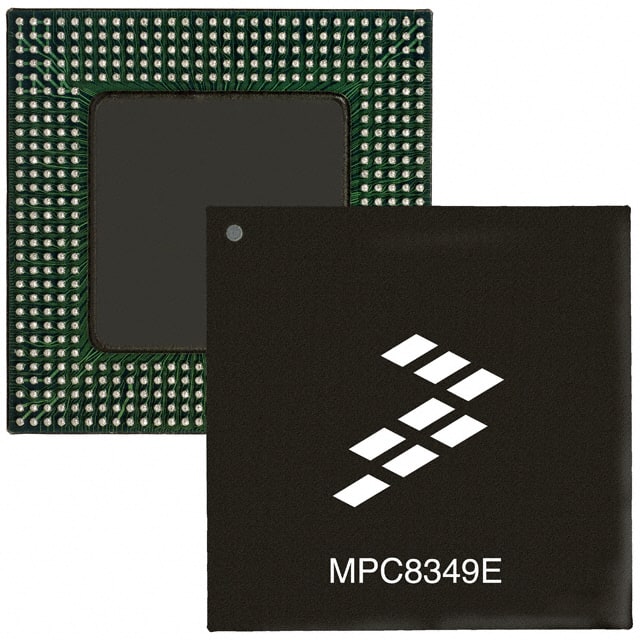Consulte las especificaciones para obtener detalles del producto.

MPC8349EVVAJDB
Product Overview
Category
MPC8349EVVAJDB belongs to the category of microprocessors.
Use
This product is commonly used in embedded systems and networking applications.
Characteristics
- High-performance microprocessor
- Power-efficient design
- Integrated peripherals for enhanced functionality
- Suitable for various industrial applications
Package
MPC8349EVVAJDB is available in a compact and durable package, ensuring easy integration into different systems.
Essence
The essence of MPC8349EVVAJDB lies in its ability to provide efficient processing power and reliable performance for embedded systems.
Packaging/Quantity
This product is typically packaged individually and is available in various quantities depending on the customer's requirements.
Specifications
- Architecture: PowerPC
- Clock Speed: Up to 400 MHz
- Cache: L1 Instruction Cache (32 KB), L1 Data Cache (32 KB), L2 Cache (256 KB)
- Memory Interface: DDR SDRAM, SRAM
- Connectivity: Ethernet, USB, UART, I2C, SPI
- Operating Voltage: 3.3V
- Operating Temperature: -40°C to +85°C
Detailed Pin Configuration
The MPC8349EVVAJDB microprocessor has a comprehensive pin configuration that includes various input/output pins, power supply pins, and ground pins. For a detailed pin diagram, please refer to the product datasheet.
Functional Features
- High-performance processing capabilities
- Integrated memory management unit (MMU) for efficient memory access
- Multiple connectivity options for seamless integration with other devices
- Support for real-time operating systems (RTOS)
- Enhanced security features for data protection
Advantages and Disadvantages
Advantages
- Powerful processing capabilities suitable for demanding applications
- Efficient power consumption for improved energy efficiency
- Wide range of integrated peripherals for enhanced functionality
- Robust and reliable performance in industrial environments
Disadvantages
- Limited clock speed compared to some contemporary microprocessors
- May require additional external components for specific applications
- Relatively higher cost compared to lower-end microprocessors
Working Principles
MPC8349EVVAJDB operates on the PowerPC architecture, utilizing a combination of high-performance processing cores, cache memory, and integrated peripherals. It executes instructions and processes data based on the program loaded into its memory, providing the desired functionality.
Detailed Application Field Plans
MPC8349EVVAJDB finds extensive application in various fields, including: 1. Networking equipment such as routers and switches 2. Industrial automation systems 3. Telecommunications infrastructure 4. Automotive electronics 5. Medical devices
Detailed and Complete Alternative Models
Some alternative models that offer similar functionality to MPC8349EVVAJDB include: 1. MPC8360E PowerQUICC II Pro 2. MPC8377E PowerQUICC II Pro 3. MPC8572 PowerQUICC III 4. MPC8641D PowerQUICC III 5. T2080 QorIQ Communication Processor
These alternative models provide comparable features and can be considered as alternatives depending on specific requirements.
Word count: 386 words
Enumere 10 preguntas y respuestas comunes relacionadas con la aplicación de MPC8349EVVAJDB en soluciones técnicas
Sure! Here are 10 common questions and answers related to the application of MPC8349EVVAJDB in technical solutions:
Q: What is the MPC8349EVVAJDB? A: The MPC8349EVVAJDB is a highly integrated system-on-chip (SoC) designed for embedded applications, offering a PowerPC core, various peripherals, and advanced connectivity options.
Q: What are the key features of the MPC8349EVVAJDB? A: The key features include a PowerPC e300 core running at up to 400 MHz, DDR2 memory controller, Ethernet MACs, USB ports, PCI interface, UARTs, I2C, SPI, and GPIOs.
Q: What kind of applications can benefit from using the MPC8349EVVAJDB? A: The MPC8349EVVAJDB is suitable for a wide range of applications such as networking equipment, industrial automation, telecommunications, and embedded systems requiring high-performance processing and connectivity.
Q: How much memory does the MPC8349EVVAJDB support? A: The MPC8349EVVAJDB supports up to 256 MB of DDR2 SDRAM, which can be expanded further using external memory controllers.
Q: What operating systems are compatible with the MPC8349EVVAJDB? A: The MPC8349EVVAJDB is compatible with various operating systems, including Linux, VxWorks, QNX, and other real-time operating systems (RTOS).
Q: Can the MPC8349EVVAJDB handle multiple Ethernet connections? A: Yes, the MPC8349EVVAJDB has two integrated Ethernet MACs, supporting 10/100 Mbps or Gigabit Ethernet connections, making it suitable for networking applications.
Q: Does the MPC8349EVVAJDB support USB connectivity? A: Yes, the MPC8349EVVAJDB includes two USB 2.0 ports, enabling easy integration with USB devices such as storage drives, peripherals, or network adapters.
Q: Can I expand the MPC8349EVVAJDB's capabilities using PCI cards? A: Yes, the MPC8349EVVAJDB features a 32-bit PCI interface, allowing you to connect additional peripherals or expansion cards for enhanced functionality.
Q: What development tools are available for programming the MPC8349EVVAJDB? A: Various development tools are available, including compilers, debuggers, and integrated development environments (IDEs) from vendors like CodeWarrior, GNU, and Green Hills Software.
Q: Are there any evaluation boards or reference designs available for the MPC8349EVVAJDB? A: Yes, Freescale (now NXP) provides evaluation boards and reference designs for the MPC8349EVVAJDB, which can help developers kickstart their projects and accelerate time-to-market.
Please note that these answers are general and may vary depending on specific implementation requirements and hardware configurations.

